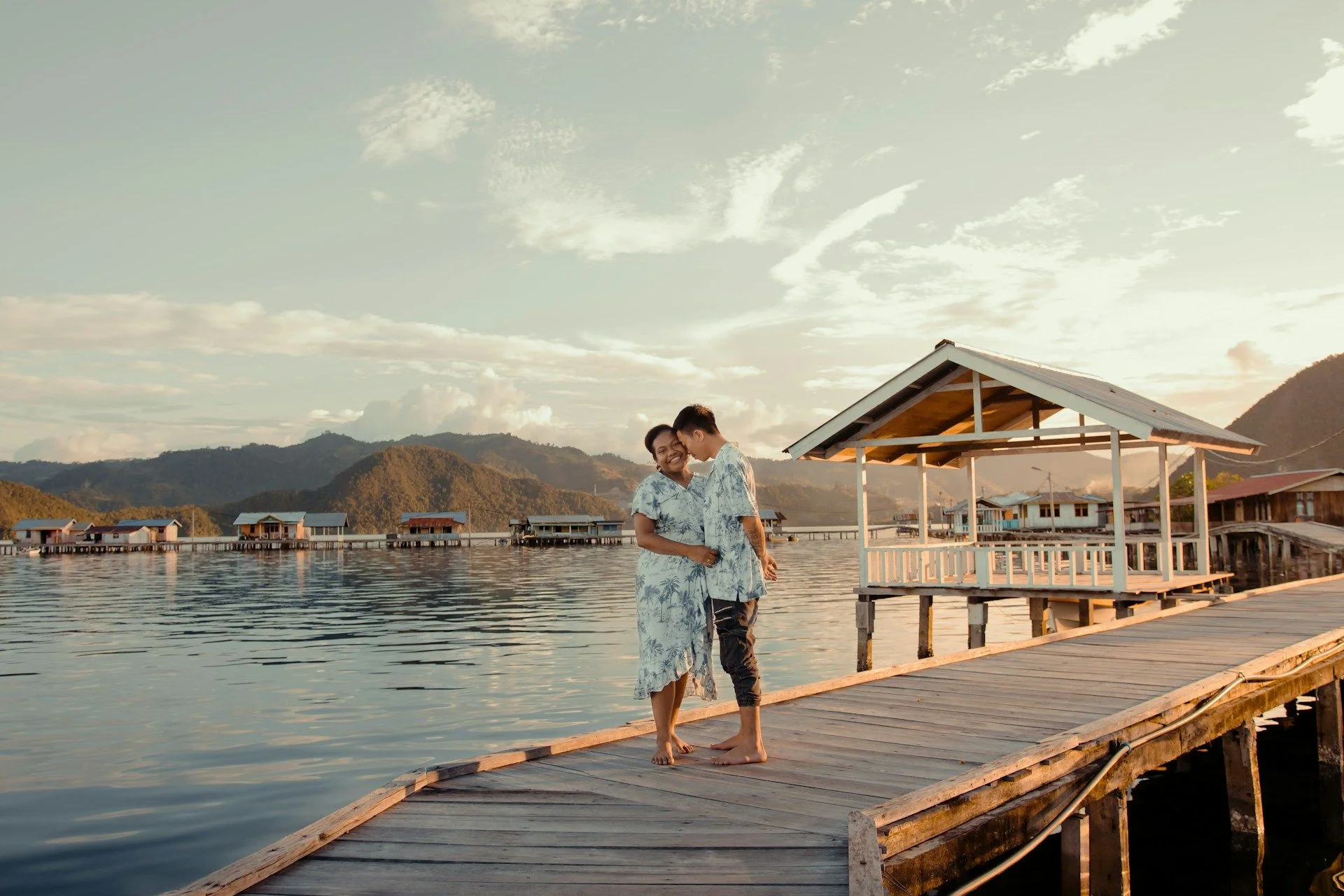Advantages of traveling
to Indonesia
Access to Raja Ampat’s coral paradise
From Sorong, travelers reach Raja Ampat—home to the most biodiverse coral reefs on Earth. Snorkeling and diving unveil pristine waters, rare species, and underwater landscapes unmatched worldwide.
Tribal traditions and highland culture
Jayapura serves as a gateway to Papua’s highlands and Lake Sentani. Travelers can experience indigenous village life, wooden carvings, and ceremonies that reflect centuries-old customs.
Wild nature and remote exploration
Papua offers jungle trekking, birdwatching, and river journeys through untouched wilderness. From cuscus sightings to hidden waterfalls, it’s a frontier for eco-adventurers seeking raw, immersive travel.
Access to Raja Ampat’s coral paradise
From Sorong, travelers reach Raja Ampat—home to the most biodiverse coral reefs on Earth. Snorkeling and diving unveil pristine waters, rare species, and underwater landscapes unmatched worldwide.
Tribal traditions and highland culture
Jayapura serves as a gateway to Papua’s highlands and Lake Sentani. Travelers can experience indigenous village life, wooden carvings, and ceremonies that reflect centuries-old customs.
Wild nature and remote exploration
Papua offers jungle trekking, birdwatching, and river journeys through untouched wilderness. From cuscus sightings to hidden waterfalls, it’s a frontier for eco-adventurers seeking raw, immersive travel.

Useful articles
and recommendations from experts
Tourism in Papua (Jayapura, Sorong): A Complete Guide
Why Papua is attractive for travelers
Indonesia’s Papua region is one of the last great frontiers of travel in Southeast Asia. Vast, diverse, and largely unexplored, it offers an entirely different side of Indonesia—defined not by beaches or volcanoes, but by impenetrable rainforests, traditional highland communities, and reefs teeming with life. Tourism in Papua (Jayapura, Sorong) attracts travelers looking for raw nature, genuine cultural encounters, and access to the world-famous diving grounds of Raja Ampat.
Jayapura, the provincial capital, sits on the north coast near the border with Papua New Guinea. It is a launch point for journeys into the highlands and Sentani Lake. Sorong, further west, is the transport hub for accessing Raja Ampat—a name that echoes in every diver’s dreams. These two cities together represent the opposite ends of Papua’s tourism: tribal lands and marine wonderlands.
Key tourism offerings and travel styles
Diving and marine exploration from Sorong
Without a doubt, the biggest draw for international travelers is the Raja Ampat archipelago, reached via ferry or speedboat from Sorong. Home to over 1,500 islands, cays, and shoals, Raja Ampat sits within the Coral Triangle and holds the highest marine biodiversity on the planet.
Here, divers and snorkelers experience soft coral gardens, manta ray cleaning stations, schooling fish, sea turtles, pigmies seahorses, and more than 500 species of coral. Popular dive sites include Manta Sandy, Blue Magic, and Melissa’s Garden. Liveaboards, eco-resorts, and homestays are available depending on your travel style and budget.
While diving is year-round, October to April is considered the best period due to calm seas and optimal visibility. Sorong itself is not a tourist destination but provides logistics, permits, and supplies for onward journeys to the islands.
Cultural immersion around Jayapura
Jayapura offers cultural depth often missed in more tropical itineraries. Just 30 minutes away is Lake Sentani, where stilt villages and wooden canoes reflect ancient ways of life. Local Papuan communities around the lake maintain traditions in woodcarving, storytelling, and ceremonial dance. Visitors can tour villages like Asei, known for bark paintings, or take boat rides to island settlements surrounded by mountain ranges.
Further inland, guided expeditions can take travelers to the Baliem Valley—home to the Dani, Lani, and Yali tribes. These trips typically begin in Wamena (accessible by flights from Jayapura) and involve trekking through valleys, attending traditional festivals, and staying in guesthouses operated by tribal communities. These are not theatrical reenactments; they are preserved cultural systems evolving on their own terms.
Nature trekking and jungle adventure
Papua is a dream destination for naturalists, birders, and conservation travelers. Its forests are among the oldest on Earth and host tree kangaroos, cuscuses, birds-of-paradise, cassowaries, and thousands of endemic plant species. Guided treks through Lorentz National Park—a UNESCO World Heritage site—take visitors from glaciers on Puncak Jaya to swampy lowlands and alpine grasslands. The scale of biodiversity is staggering.
River journeys, such as those along the Mamberamo River, allow deeper immersion. These trips often involve tent camps, forest walks, and interaction with communities practicing sustainable hunting and gathering. However, such expeditions require experienced local operators, permits, and flexible planning.
Birdwatchers are especially drawn to Arfak Mountains and Nimbokrang, where rare species like the King Bird-of-paradise and the Western Parotia can be spotted. Trekking here is best in the dry season and usually paired with community-based eco-lodges.
Local logistics and visitor regulations
Travel in Papua is logistically complex but deeply rewarding. Sorong is served by Domine Eduard Osok Airport (SOQ) with flights from Jakarta, Makassar, and Manado. Jayapura’s Sentani International Airport (DJJ) connects with major Indonesian cities and acts as the hub for inter-island and highland connections.
All foreign travelers require a special Surat Jalan (travel permit) for visiting certain tribal regions or border zones. These can typically be arranged by your tour operator or at police stations with copies of your passport and visa. Raja Ampat also requires a marine park entrance fee, which helps support conservation efforts.
Transportation within Papua involves a mix of flights, ferries, 4x4 vehicles, boats, and trekking. Infrastructure is limited in rural zones—expect slow, scenic journeys and frequent schedule adjustments. In Raja Ampat, island transfers are by speedboat, while village stays often include meals and guided activities.
ATMs are available in Jayapura and Sorong but rare beyond them. It is advised to carry sufficient cash, especially for homestays and tribal markets. Bahasa Indonesia is the official language, though English is spoken in tourism hubs and by licensed guides. Papuan languages and dialects are still widely used, adding to the sense of cultural richness.
Seasonal demand and visitor flows
Tourism in Papua remains low-density and seasonal. October to April is ideal for marine activities in Raja Ampat, with calm seas and high visibility. During this time, most liveaboards and diving operators run full schedules. Outside these months, heavy rains and storms can disrupt plans.
Highland regions like Baliem Valley are best visited from May to September, when the trails are dry and festivals—such as the famous Baliem Valley Cultural Festival—take place. This celebration of tribal culture includes mock battles, dance, music, and storytelling in the valley’s amphitheater-like setting.
Unlike Bali or Jakarta, Papua does not experience tourist overcrowding. However, accommodations in Raja Ampat and Wamena should be booked well in advance due to limited capacity and high demand among nature travelers and divers.
Why choose Papua for your next trip
Papua is not an easy destination, but it is a transformative one. For those who seek more than comfort—for those who seek meaning, challenge, and connection—Papua delivers. Its landscapes feel mythic: rainforest peaks shrouded in clouds, lakeside villages lit by sunset, reefs that shimmer with impossible colors.
It’s a place where tourism must align with respect—for cultures that continue without outside validation, for ecosystems that thrive without interference. Papua gives you a sense of scale—of human diversity, of natural power, and of the sheer vastness of the world.
Whether you come for the diving or the trekking, the music or the mountains, the real beauty of Papua lies in its refusal to be simplified. It’s a land that invites humility and rewards curiosity.
How VelesClub Int. supports travel planning
VelesClub Int. specializes in remote and responsible travel. In Papua, we provide access to verified local partners, permit handling, bilingual guides, and curated itineraries that prioritize sustainability and cultural integrity.
From Raja Ampat diving tours and Sorong liveaboards to Jayapura cultural visits and Baliem treks, our services ensure your safety, comfort, and deeper connection with the region. Whether you’re planning a diving expedition or a village homestay, VelesClub Int. makes your Papua journey possible—and meaningful.

